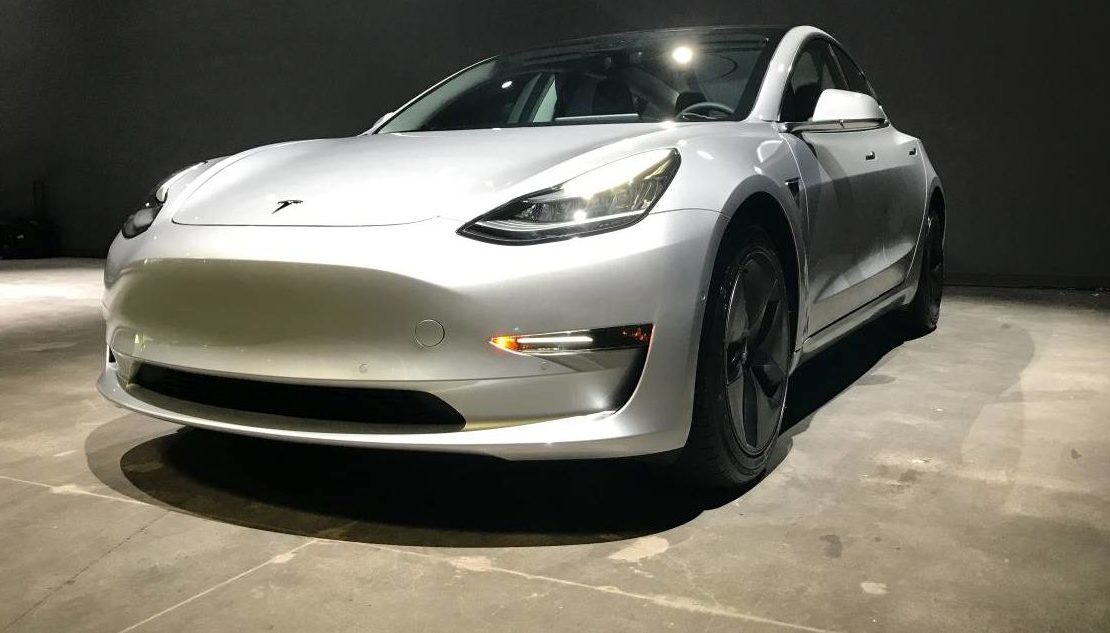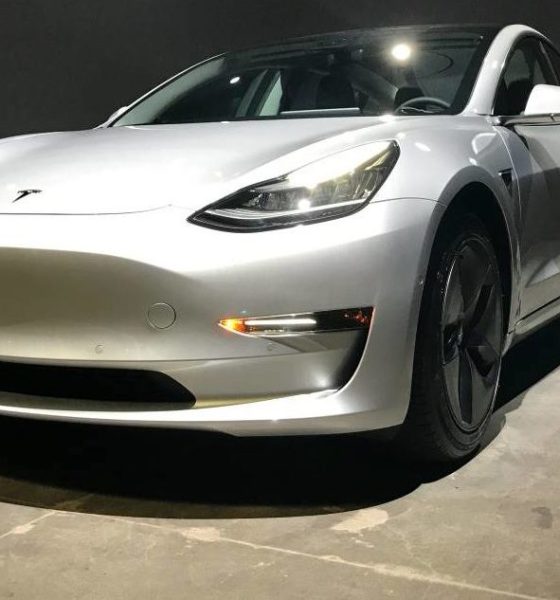

Investor's Corner
Tesla Model 3 in $35k Standard trim will have an AWD Dual Motor option
Tesla confirmed on Friday that the $35,000 Standard trim Model 3 could be upgraded with a dual motor AWD option.
The dual motor AWD upgrade costs $5,000 for the Long Range RWD version of the electric car. If Tesla does not adjust its pricing for the upgrade, a Standard trim Model 3 with dual motor AWD would likely be priced around $40,000. In comparison, Tesla’s Long Range Model 3 with dual motor AWD is priced at $54,000 before additional options such as premium paint, 19″ Sport Wheels, and Autopilot.
Yes
— Tesla (@Tesla) August 9, 2018
Tesla’s $35,000 Standard trim Model 3 is arguably one of the most anticipated vehicles in the company’s lineup. When Elon Musk wrote his Master Plan back in 2006, he mentioned using the money earned from the sales of medium-volume cars like the Model S and X to fund the development and release of an affordable, high-volume car. The Model 3 is that vehicle — a car designed to push Tesla into the mainstream car market. The $35,000 starting price of the Standard trim Model 3 is a huge draw to the vehicle, helping Tesla hit its record-breaking reservation numbers when it was unveiled back in 2016.
It could be said that the $35,000 base Model 3 is Tesla’s most ambitious vehicle to date. While it does not have all the bells and whistles of its more expensive siblings like the Model 3 Performance, the base Model 3 is still a capable electric car. Its battery pack, comprised of Tesla’s new 2170 cells, is expected to provide the vehicle with 220 miles of range per charge. The speed of the Standard trim Model 3 is not to be scoffed at, either, with its 0-60 mph time of 5.6 seconds and a top speed of 130 mph. The base Model 3 is also fitted with Tesla’s industry-leading safety systems, including 8 cameras, forward radar, and 12 ultrasonic sensors that enable features such as collision avoidance and automatic emergency braking.
Inasmuch as the $35,000 Standard trim Model 3 would likely be a huge success when it enters the market, Tesla’s production rollout for the vehicle has experienced delays as the company faced challenge after challenge over the past year. Musk explained these delays in an update on Twitter last May, when he stated that if Tesla manufactures the $35,000 Model 3 while the company’s production output is not optimized yet, it will cause Tesla to lose money.
With production, 1st you need achieve target rate & then smooth out flow to achieve target cost. Shipping min cost Model 3 right away wd cause Tesla to lose money & die. Need 3 to 6 months after 5k/wk to ship $35k Tesla & live.
— Elon Musk (@elonmusk) May 21, 2018
An update to the $35,000 Standard trim Model 3 was announced by Elon Musk on the 2018 Annual Shareholder Meeting, when he stated that production of the Standard trim’s smaller battery pack would likely begin sometime at the end of the year. Musk also suggested that the vehicle would probably see a release in early 2019.
“Yes. We will definitely offer a $35,000 version of the Model 3. And probably at the end of this year is when we will be able to make a smaller version of the battery pack, and get into volume production of $35,000 version in Q1 next year. We would definitely honor that obligation, and we would do so right now if it were possible,” Musk said.
Tesla only makes three variants of the Model 3 today — the Long Range RWD, Dual Motor AWD, and Performance versions — but the vehicle is already starting to make an impact in the United States’ auto industry. In July alone, the Model 3 ranked seventh in GoodCarBadCar‘s list of America’s Top 20 best-selling vehicles list, which includes gas-powered cars like the Toyota Camry. Once the $35,000 Standard trim Model 3 enters the fray, Tesla’s newest electric car would likely command an even bigger piece of the car market.

Investor's Corner
Tesla stock closes at all-time high on heels of Robotaxi progress

Tesla stock (NASDAQ: TSLA) closed at an all-time high on Tuesday, jumping over 3 percent during the day and finishing at $489.88.
The price beats the previous record close, which was $479.86.
Shares have had a crazy year, dipping more than 40 percent from the start of the year. The stock then started to recover once again around late April, when its price started to climb back up from the low $200 level.
This week, Tesla started to climb toward its highest levels ever, as it was revealed on Sunday that the company was testing driverless Robotaxis in Austin. The spike in value pushed the company’s valuation to $1.63 trillion.
Tesla Robotaxi goes driverless as Musk confirms Safety Monitor removal testing
It is the seventh-most valuable company on the market currently, trailing Nvidia, Apple, Alphabet (Google), Microsoft, Amazon, and Meta.
Shares closed up $14.57 today, up over 3 percent.
The stock has gone through a lot this year, as previously mentioned. Shares tumbled in Q1 due to CEO Elon Musk’s involvement with the Department of Government Efficiency (DOGE), which pulled his attention away from his companies and left a major overhang on their valuations.
However, things started to rebound halfway through the year, and as the government started to phase out the $7,500 tax credit, demand spiked as consumers tried to take advantage of it.
Q3 deliveries were the highest in company history, and Tesla responded to the loss of the tax credit with the launch of the Model 3 and Model Y Standard.
Additionally, analysts have announced high expectations this week for the company on Wall Street as Robotaxi continues to be the focus. With autonomy within Tesla’s sights, things are moving in the direction of Robotaxi being a major catalyst for growth on the Street in the coming year.
Elon Musk
Tesla needs to come through on this one Robotaxi metric, analyst says
“We think the key focus from here will be how fast Tesla can scale driverless operations (including if Tesla’s approach to software/hardware allows it to scale significantly faster than competitors, as the company has argued), and on profitability.”

Tesla needs to come through on this one Robotaxi metric, Mark Delaney of Goldman Sachs says.
Tesla is in the process of rolling out its Robotaxi platform to areas outside of Austin and the California Bay Area. It has plans to launch in five additional cities, including Houston, Dallas, Miami, Las Vegas, and Phoenix.
However, the company’s expansion is not what the focus needs to be, according to Delaney. It’s the speed of deployment.
The analyst said:
“We think the key focus from here will be how fast Tesla can scale driverless operations (including if Tesla’s approach to software/hardware allows it to scale significantly faster than competitors, as the company has argued), and on profitability.”
Profitability will come as the Robotaxi fleet expands. Making that money will be dependent on when Tesla can initiate rides in more areas, giving more customers access to the program.
There are some additional things that the company needs to make happen ahead of the major Robotaxi expansion, one of those things is launching driverless rides in Austin, the first city in which it launched the program.
This week, Tesla started testing driverless Robotaxi rides in Austin, as two different Model Y units were spotted with no occupants, a huge step in the company’s plans for the ride-sharing platform.
Tesla Robotaxi goes driverless as Musk confirms Safety Monitor removal testing
CEO Elon Musk has been hoping to remove Safety Monitors from Robotaxis in Austin for several months, first mentioning the plan to have them out by the end of 2025 in September. He confirmed on Sunday that Tesla had officially removed vehicle occupants and started testing truly unsupervised rides.
Although Safety Monitors in Austin have been sitting in the passenger’s seat, they have still had the ability to override things in case of an emergency. After all, the ultimate goal was safety and avoiding any accidents or injuries.
Goldman Sachs reiterated its ‘Neutral’ rating and its $400 price target. Delaney said, “Tesla is making progress with its autonomous technology,” and recent developments make it evident that this is true.
Investor's Corner
Tesla gets bold Robotaxi prediction from Wall Street firm
Last week, Andrew Percoco took over Tesla analysis for Morgan Stanley from Adam Jonas, who covered the stock for years. Percoco seems to be less optimistic and bullish on Tesla shares, while still being fair and balanced in his analysis.

Tesla (NASDAQ: TSLA) received a bold Robotaxi prediction from Morgan Stanley, which anticipates a dramatic increase in the size of the company’s autonomous ride-hailing suite in the coming years.
Last week, Andrew Percoco took over Tesla analysis for Morgan Stanley from Adam Jonas, who covered the stock for years. Percoco seems to be less optimistic and bullish on Tesla shares, while still being fair and balanced in his analysis.
Percoco dug into the Robotaxi fleet and its expansion in the coming years in his latest note, released on Tuesday. The firm expects Tesla to increase the Robotaxi fleet size to 1,000 vehicles in 2026. However, that’s small-scale compared to what they expect from Tesla in a decade.
Tesla expands Robotaxi app access once again, this time on a global scale
By 2035, Morgan Stanley believes there will be one million Robotaxis on the road across multiple cities, a major jump and a considerable fleet size. We assume this means the fleet of vehicles Tesla will operate internally, and not including passenger-owned vehicles that could be added through software updates.
He also listed three specific catalysts that investors should pay attention to, as these will represent the company being on track to achieve its Robotaxi dreams:
- Opening Robotaxi to the public without a Safety Monitor. Timing is unclear, but it appears that Tesla is getting closer by the day.
- Improvement in safety metrics without the Safety Monitor. Tesla’s ability to improve its safety metrics as it scales miles driven without the Safety Monitor is imperative as it looks to scale in new states and cities in 2026.
- Cybercab start of production, targeted for April 2026. Tesla’s Cybercab is a purpose-built vehicle (no steering wheel or pedals, only two seats) that is expected to be produced through its state-of-the-art unboxed manufacturing process, offering further cost reductions and thus accelerating adoption over time.
Robotaxi stands to be one of Tesla’s most significant revenue contributors, especially as the company plans to continue expanding its ride-hailing service across the world in the coming years.
Its current deployment strategy is controlled and conservative to avoid any drastic and potentially program-ruining incidents.
So far, the program, which is active in Austin and the California Bay Area, has been widely successful.








